Dr. Phil Zeltzman’s Blog
You removed this poor dog’s what???
Bodie, a 5 month old Pitbull, was in a pickle…

He had skin missing in his prepuce, which led to exposure of a portion of his penis. Because he was a rescue, there was no known cause. Most likely, this was due to trauma (ie a dog bite), or he was born that way.
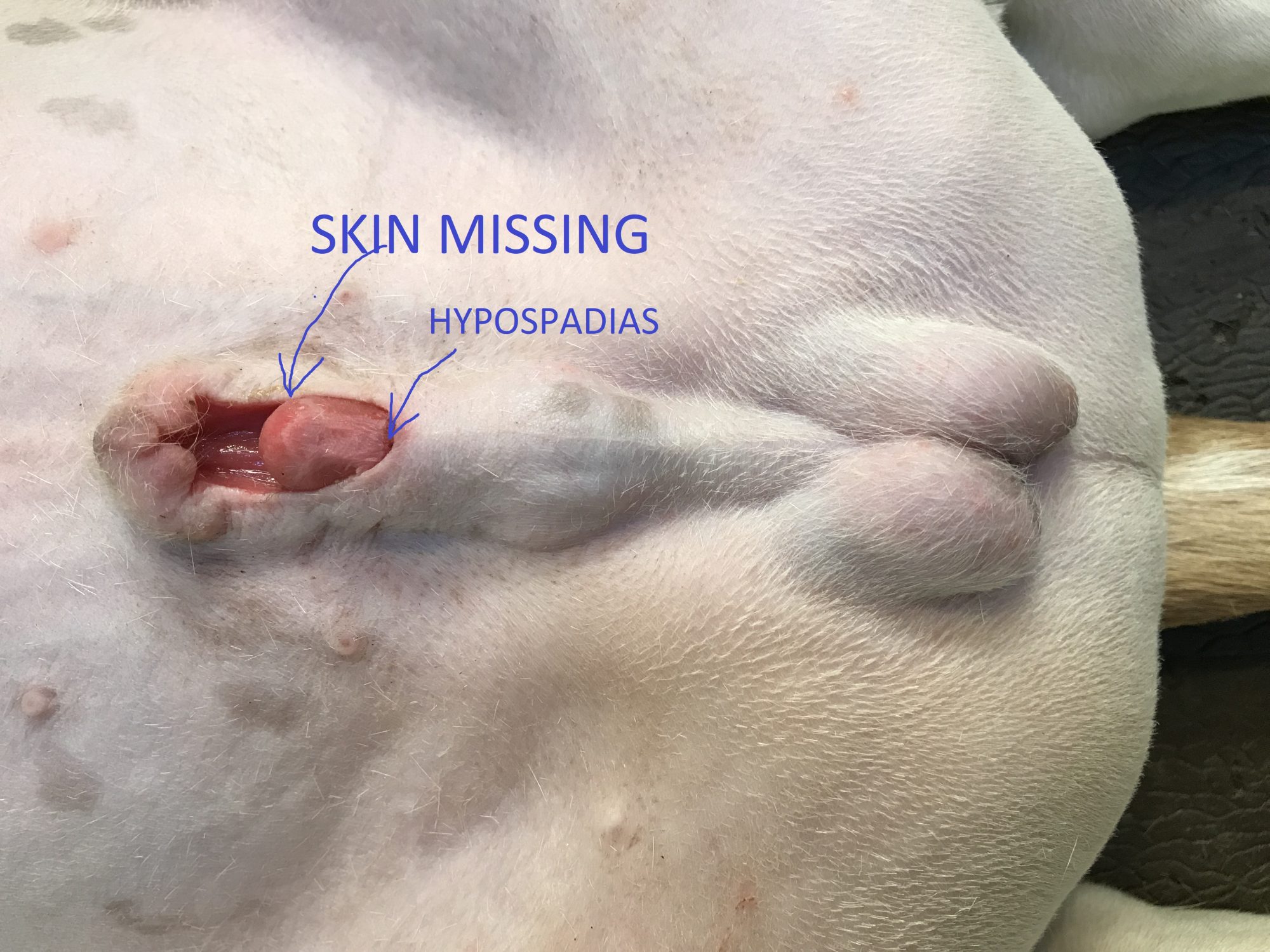
In addition, he had a hypospadias. A what? A hypospadias is a congenital condition in which the opening of the urethra is located under the penis, instead of the tip. This caused problems to urinate.
Bodie was relinquished to a rescue, presumably because his original owner did not want to deal with a dog with this condition.
The only treatment was surgery. There were 2 options: either try to reconstruct a new prepuce, or remove the entire penis (penile amputation). With the second option, a new opening would be created to allow Bodie to urinate (urethrostomy). This new opening is located where the scrotum is.
Given the hypospadias, it was deemed preferable to sacrifice Bodie’s penis.
A full physical exam and blood work confirmed that Bodie was healthy enough to undergo anesthesia.
Surgery went well, and Bodie recovered smoothly from anesthesia.
He went home on pain medications and antibiotics. Instructions included wearing an E-collar (plastic cone) and rest strictly for 3 weeks.
Three weeks later, Bodie returned to the clinic for a progress exam and staple removal. He received a clean bill of health. He was urinating well and seemed completely unaffected by this surgical adventure.
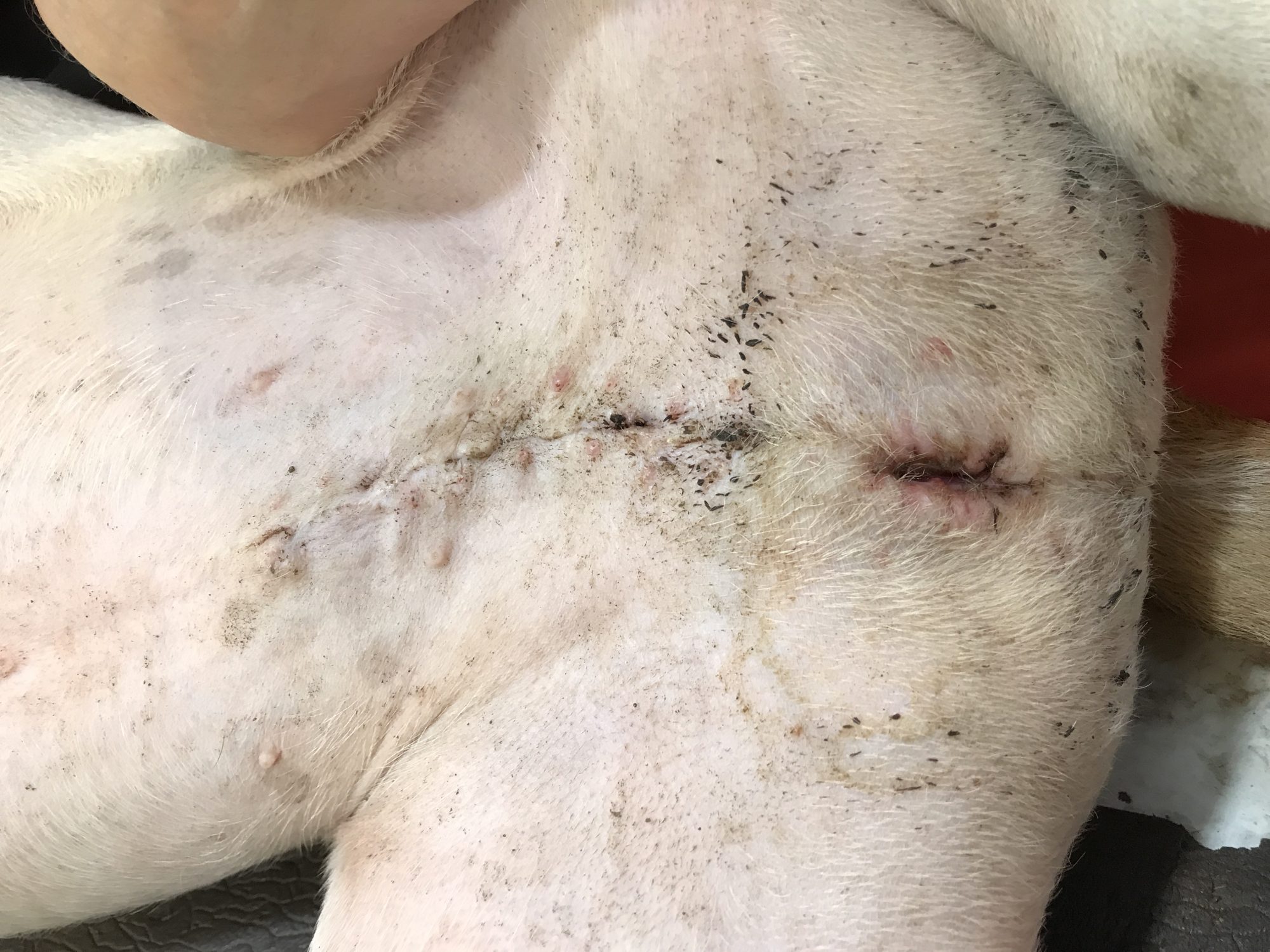
Bodie got a second chance at a comfortable life by ending up in the hands of a generous rescuer who fell in love with him. She was willing to go the extra mile to give him the life he deserves: peeing freely on all the trees in the neighborhood.
He can now look forward to a long and healthy life in his new furever home.
Phil Zeltzman, DVM, DACVS, CVJ, Fear Free Certified

Dr. Phil Zeltzman is a traveling veterinary surgeon in Pennsylvania & New Jersey. An award-winning author, he loves to share his adventures in practice along with information about vet medicine and surgery that can really help your pets. Dr. Zeltzman specializes in orthopedic, neurologic, cancer, and soft tissue surgeries for dogs, cats, and small exotics. By working with local family vets, he offers the best surgical care, safest anesthesia, and utmost pain management to all his patients. Sign up to get an email when he updates his blog, and follow him on Facebook, too!
How Madeline got a new lease on life
Madeline, a 7-year-old shepherd mix, had trouble urinating for about two months.
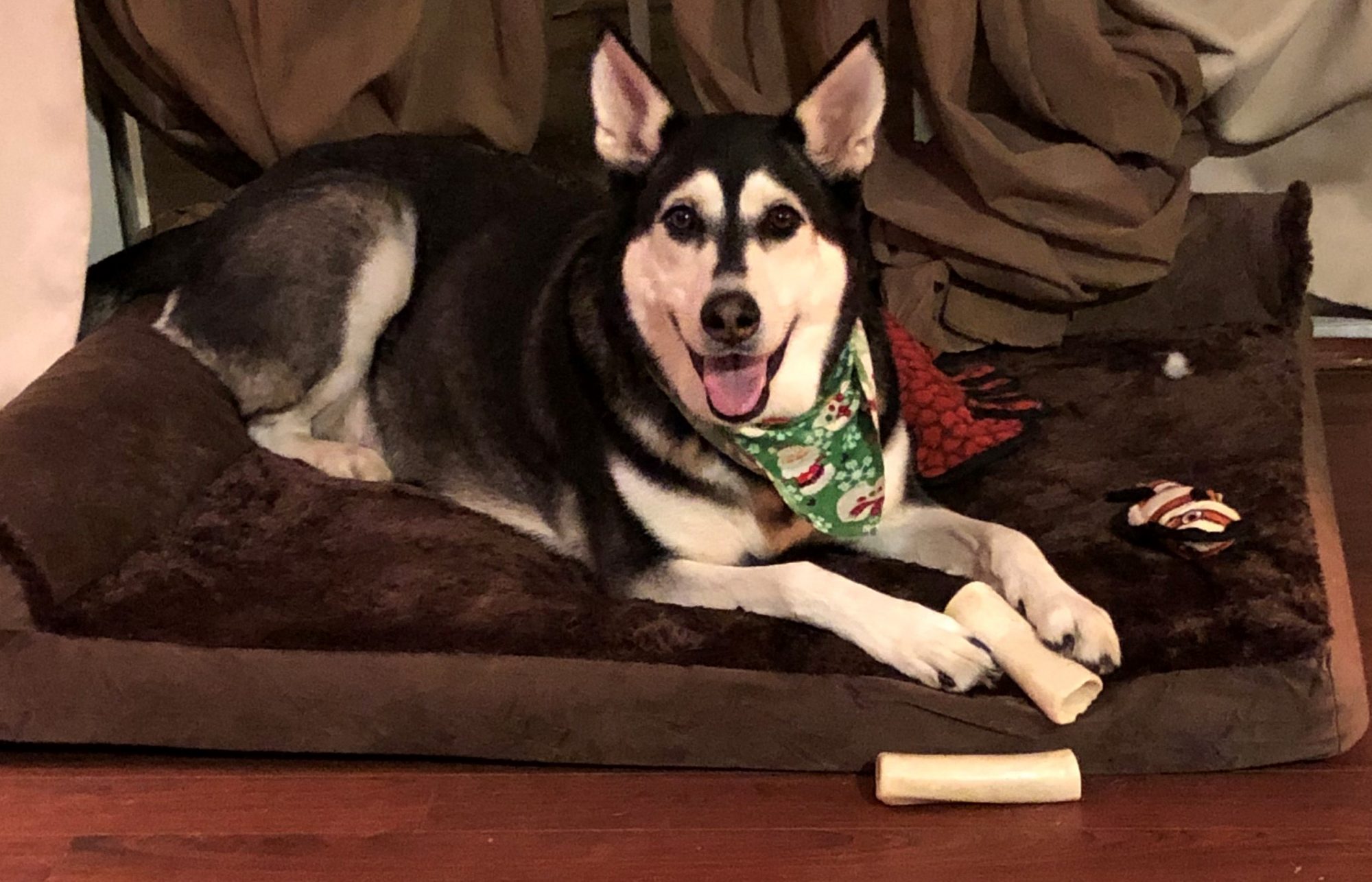
(You can tell from her picture that she’s not at all a spoiled pup!)
Fair warning: this is an unusually long blog. It’s longer than a tweet. If you read it until the end, you will learn several valuable lessons that could save your pet’s life one day. So please hang in there and read along. It’s actually a quick read!
Madeline would strain to urinate, with frequent attempts, and accidents in the house. There was no blood in the urine, which made it less likely to be a bladder infection.
X-rays didn’t show anything unusual, including bladder stones.
After two months of trying various treatments (antibiotics, steroids etc) that didn’t make any difference, Madeline’s owner got rather frustrated and went elsewhere to get an ultrasound. And that was the key decision: the ultrasound showed a mass in her bladder. Rather than being in an area where it’s easy to remove (eg the front of the bladder), it was located in the very back, at the junction of the bladder and the urethra (the tube between the bladder and the outside world). This area is called the trigone. It’s the muscle that allows a dog to be continent, ie the opposite of incontinent. This made removing the mass risky.
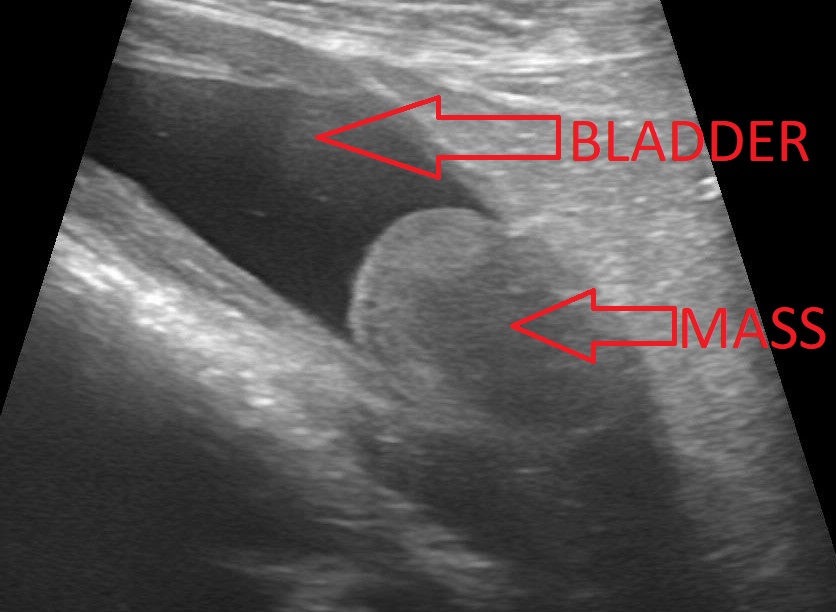
Depending on its position, the mass would randomly block the urethra, making it impossible for Madeline to urinate. Not only is this incredibly uncomfortable, it can lead to all kinds of complications including severe kidney damage.
Madeline’s owners went to several family vets and specialists to find a solution. They were told that the mass could not be removed or it would cause urinary incontinence. That it was in multiple locations in the bladder. That it was most likely cancer. And it was most likely a transitional cell carcinoma.
The only treatment suggested was radiation therapy – for $11,000. They were told that it may cause increased irritation of the bladder, which would lead to incontinence. “So the treatment could do more harm than good” explained Madeline’s owner.
She added: “We felt hopeless. Neither of us could focus on work. Every day, we would wake up not knowing if this was the day that our dog would not be able to urinate and we would have to put her down. I felt like the vets gave our dog a death sentence with no answers and no option for her to have any help whatsoever. This did not seem right to me. It did not seem ethical. We asked them desperately what they recommended and they told us if there is one thing that they could recommend, “it is not to get surgery.” They did recommend that we get her kidneys checked. Her kidneys were slightly enlarged, therefore she has no more than two weeks to live. We needed to monitor her closely to see when things got worse because then we would know when to put her down.”
The most often recommended palliative treatment for transitional cell carcinoma is a drug called piroxicam. It’s an anti-inflammatory drug, which side-effects include stomach ulcers.
So that’s what was prescribed for Madeline. Nothing else.
It is very tricky for me to write what follows, out of respect for the colleagues who were in charge of Madeline. But when solutions exist, I firmly believe that they should be offered to a loving, motivated pet owner. Then it’s their decision to accept or decline the treatment plan.
Madeline’s owner found me through my website, and they reached out for help. I had a few important concerns:
. Everybody was convinced this mass was cancerous, but there was no proof.
. No biopsy was suggested. The whole treatment plan (piroxicam) was founded on an assumption: that just because the most common bladder is transitional cell carcinoma, then that’s what Madeline had.
. And my most pressing concern: no immediate solution was offered to help her empty her bladder, which can absolutely lead to a life-threatening situation.
Madeline’s owner comments: “She went through an extended period of time being unable to urinate at all. No vet, emergency vet or specialist anywhere around us would give her immediate relief through a urinary catheter. I called Dr. Zeltzman in a panic and he immediately set us up with a clinic that would do the procedure. Luckily, she was able to urinate shortly after this and this was no longer an imminent need.”
. Surgery was completely eliminated as a solution by several specialists, including a surgeon.
So Madeline’s owners and I had a heart-to-heart discussion. After reviewing her medical record and ultrasound report, I suggested a 2-step surgery:
Part 1. Remove as much of the tumor as possible.
Yes, it was probable that we wouldn’t get it all.
Yes, it was likely that the tumor would regrow over time.
Yes, cancer was all over the bladder according to the ultrasound.
Yes, there was a risk of urinary incontinence.
But how exactly was Madeline supposed to empty her bladder with this mass blocking her urine? Trying to remove part of it would also allow sending a biopsy to the lab to get an actual diagnosis.
In addition, we’d know if piroxicam is the correct treatment.
Part 2. Then, we could offer my top-secret weapon: a solution to drain the bladder, short-term as well as short-term.
Of course, I’m joking. There is nothing secret about this solution. It’s in every surgery book.
I insisted several times that my solution “is not for everybody.” I explained that there were possible complications, such as repeated bladder infections. After several conversations, Madeline’s owners took a giant leap of faith. They went against the advice of multiple other vets, including specialists. And they asked me to put this plan into action.
WARNING – the next picture is graphic.
Prior to anesthesia, Madeline’s blood work was checked again to make sure her kidneys were functioning normally and there was no secondary issue caused by her urinary blockage. Everything came back normal and she was prepped for surgery.
Again, the 1st step was to remove the tumor. It was a little bit bigger than a dime. Small, but potentially deadly. It clearly blocked the entire urethra. It was removed as gently as possible from inside the bladder/urethra junction.
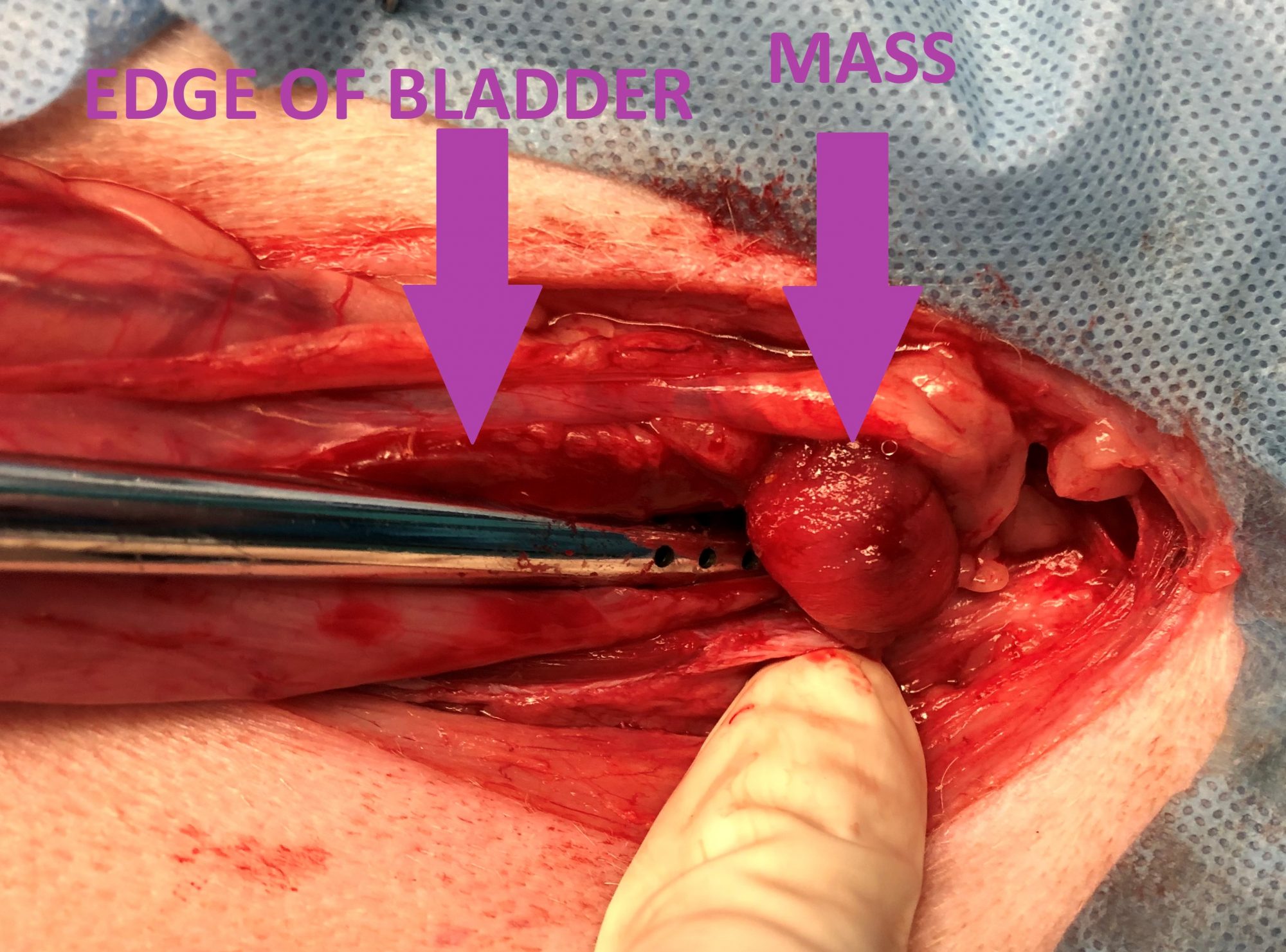
The rest of the bladder felt normal to the touch and looked normal. There were no obvious signs of spreading throughout the bladder.
Next, came my no-so-secret weapon: it’s a special tube called a cystostomy tube. This is a soft tube that is placed in the bladder and comes out of a small incision in the belly. The tube has a special valve attached to it to control the flow of urine, allowing the owners to empty the bladder as needed. The tube can remain in place in the short-term. In Madeline’s case, it may very well stay in for life.
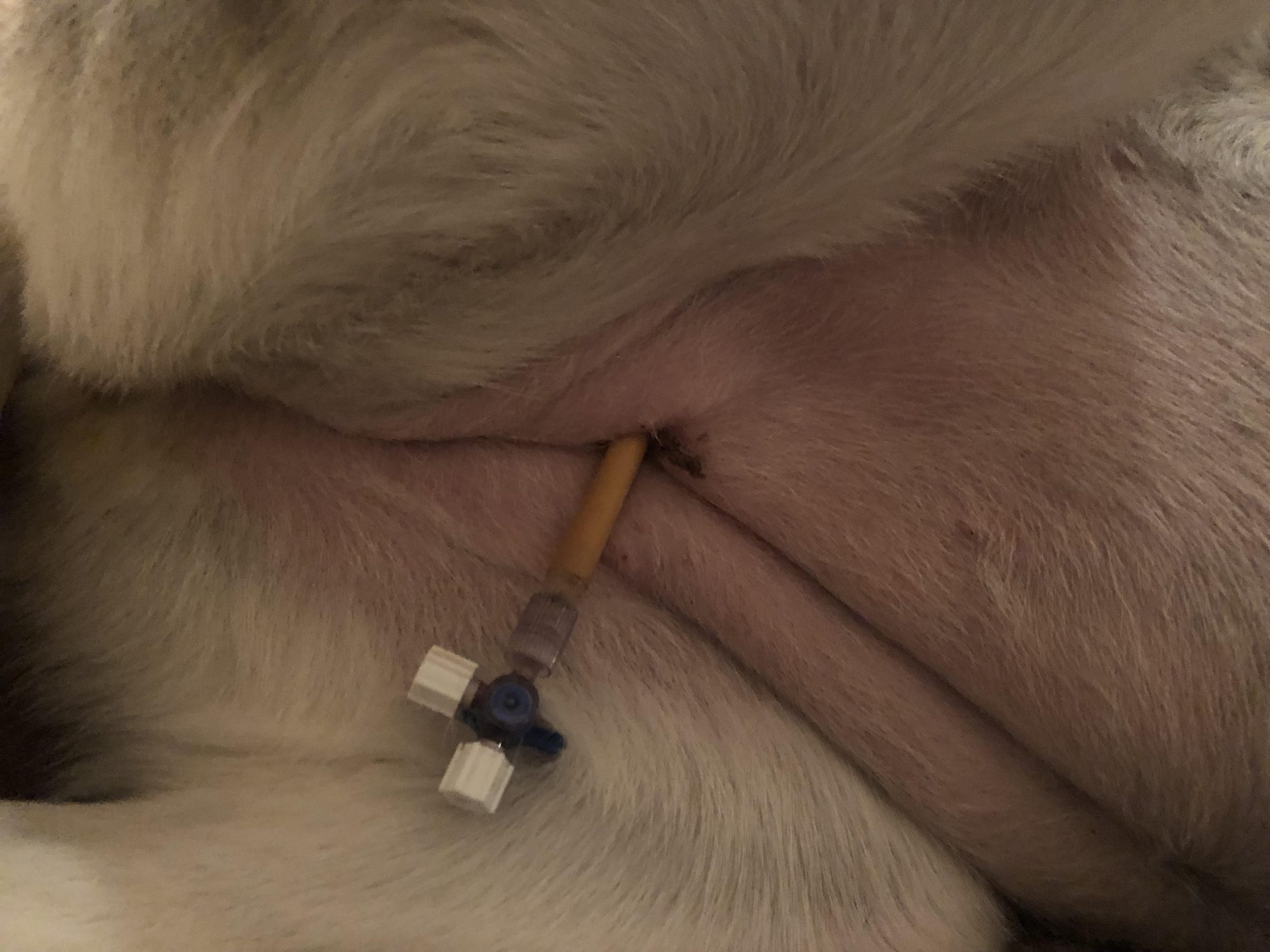
Surgery went very well and Madeline recovered smoothly. She went home after her owners were showed how to care for the cystostomy tube.
No big surprise, she was able to urinate on her own shortly following surgery, which was a relief – literally! Regardless, I instructed her owners to use the tube once a day to get comfortable with it. This way, they would be proficient at using it, the day it might be the only option Madeline has to empty her bladder…
About 1 week after surgery, the biopsy report came back. Guess what? Madeline’s tumor was not transitional cell carcinoma! Sadly, it was cancer. It is a rare tumor of the muscle of the bladder called leio-myo-sarcoma. Which doesn’t responds to piroxicam.
Amazingly, the pathologist said that we got it all – although with “very narrow margins”, which means that it is likely to come back.
A week after surgery, Madeline was doing “fantastic”. She was urinating on her own normally. Her owners “could not be happier.” They were taking excellent care of her cystostomy tube and emptying the bladder once daily as instructed.
Two weeks after surgery, the staples were removed. Her owner commented: “We’re doing great! Never happier! Madeline is doing fantastic! It is almost like she knows that her life was saved and she is showering us in kisses to show us her appreciation. She has completely adapted to wearing a cone and even carries her ball around in her cone! The incision site looks clean and dry. We’re so thrilled with how she has progressed so far. We cannot thank you enough for all you have done.”
I guess the giant leap of faith was the right decision…
Please understand that my point in sharing Madeline’s story is not to brag. My goal is not to show that I am smarter than anybody else.
My goal however, is to remind loving pet owners of a few important, simple facts (which long-time readers have read about many times before in this blog):
. Don’t make assumption when it comes to a cancer diagnosis. Lives are at stake here. Demand proof of the diagnosis – when possible. I’ve treated many “cancer” patients who never had cancer at all…
. Trust your gut. If you are not comfortable with a practice, or a vet, or a treatment plan, then get a 2nd or a 3rd opinion. Within reason of course.
. Just because you’re not a vet doesn’t mean that you can’t use your own logic. If there is a blockage, are there viable solutions to relieve it? If cancer is suspected, can we prove it? Can we find out which type before a treatment is recommended?
Madeline’s owners unknowingly did all of that. They weren’t satisfied with the lack of options to help their dog. They thought that there might be a better solution than a death sentence. Fortunately for Madeline, they were right.
We don’t know how long Madeline will be around. Bladder cancer is a serious diagnosis. To me, and to her owners, it’s not so much a matter of quantity of life (ie survival), it’s mostly a matter of quality of life. Being able to urinate freely is one of the mandatory requirements.
Madeline owner concludes: “We couldn’t be more grateful for what Dr. Zeltzman has done. Although we do know that she still has cancer, Dr. Zeltzman gave us more time with our baby. Most importantly, he gave us options while giving her pain relief.“
Phil Zeltzman, DVM, DACVS, CVJ, Fear Free Certified

Dr. Phil Zeltzman is a traveling veterinary surgeon in Pennsylvania & New Jersey. An award-winning author, he loves to share his adventures in practice along with information about vet medicine and surgery that can really help your pets. Dr. Zeltzman specializes in orthopedic, neurologic, cancer, and soft tissue surgeries for dogs, cats, and small exotics. By working with local family vets, he offers the best surgical care, safest anesthesia, and utmost pain management to all his patients. Sign up to get an email when he updates his blog, and follow him on Facebook, too!
Are X-rays to diagnose an ACL tear a waste of money?
Pet owners regularly question why we take X-rays to diagnose an ACL tear. After all, an ACL is “soft tissue”, and you can’t see it on X-rays. This is actually a very valid point. So why bother? Is it a waste of money? Are we taking loving pet owners for a ride?
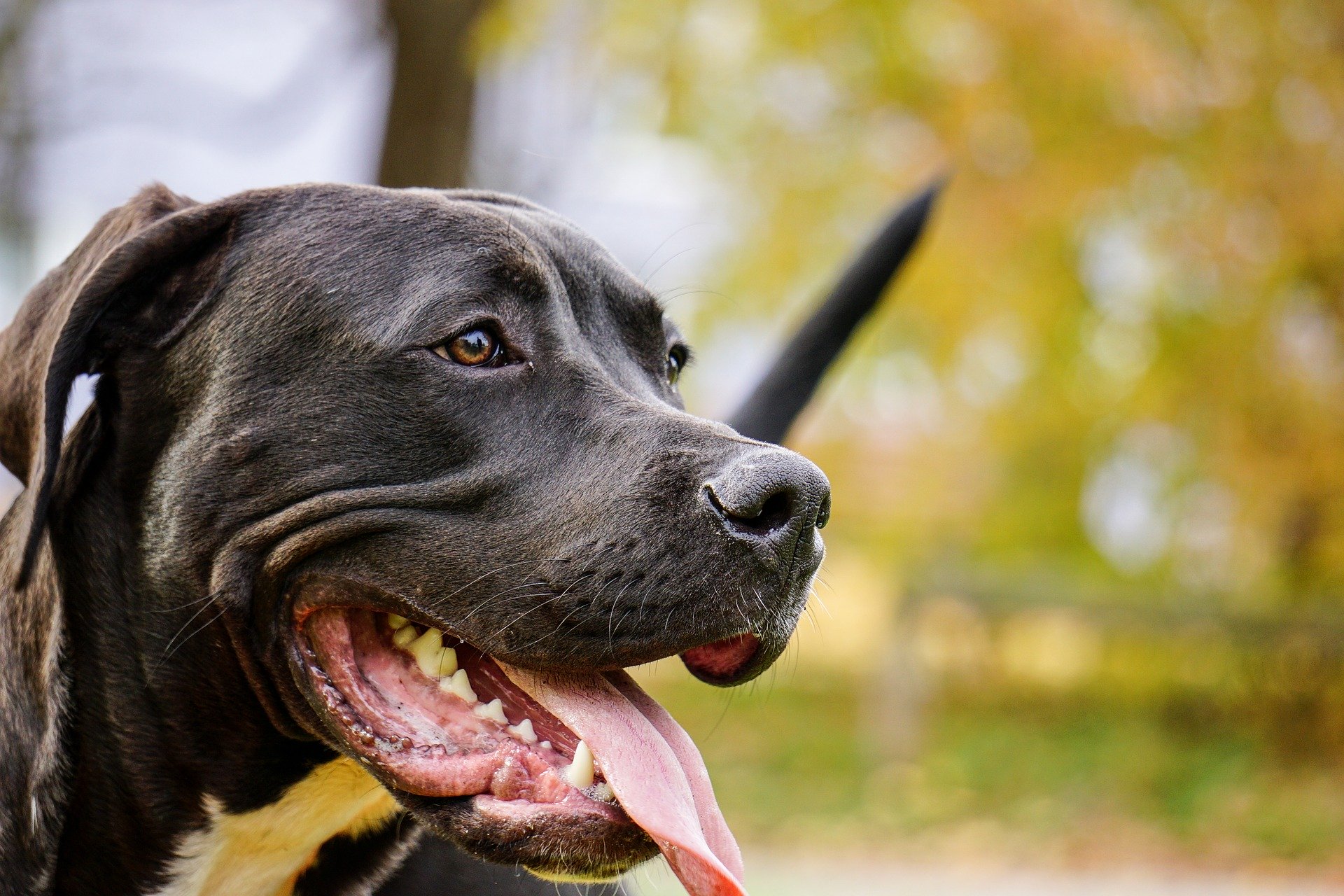
The story of Zeus, a 3 year old pit bull, is a perfect way to explain why it is so important to take X-rays before ACL surgery.
Reasons include:
. An experienced family vet or a surgeon can actually diagnose an ACL tear on X-rays. Sure, we can’t see the ACL, but we can see the consequences of the tear: too much fluid in the joint, arthritis, displacement (or dislocation) of the thigh bone and the shin bone etc.
. In order to do a TPLO or a TTA, we need to take measurements to plan the entire surgery, so X-rays are mandatory. By the way, the X-rays must be in a very specific position, and require sedation. If the leg it crooked before the patient is awake or struggling, the measurements will be off, and the outcome of the surgery may be affected.
. Before any type of repair, we need to make sure that there isn’t something else going on. It could be something benign, like a fracture. This was recently the case of Ellie, a 6 month old English Bulldog, who was thought to have a torn ACL. A simple X-ray clearly showed that she had in fact a fracture of the shin bone (tibial crest avulsion). Note how the fracture piece (red arrow) is lifted off its normal position (green arrow).
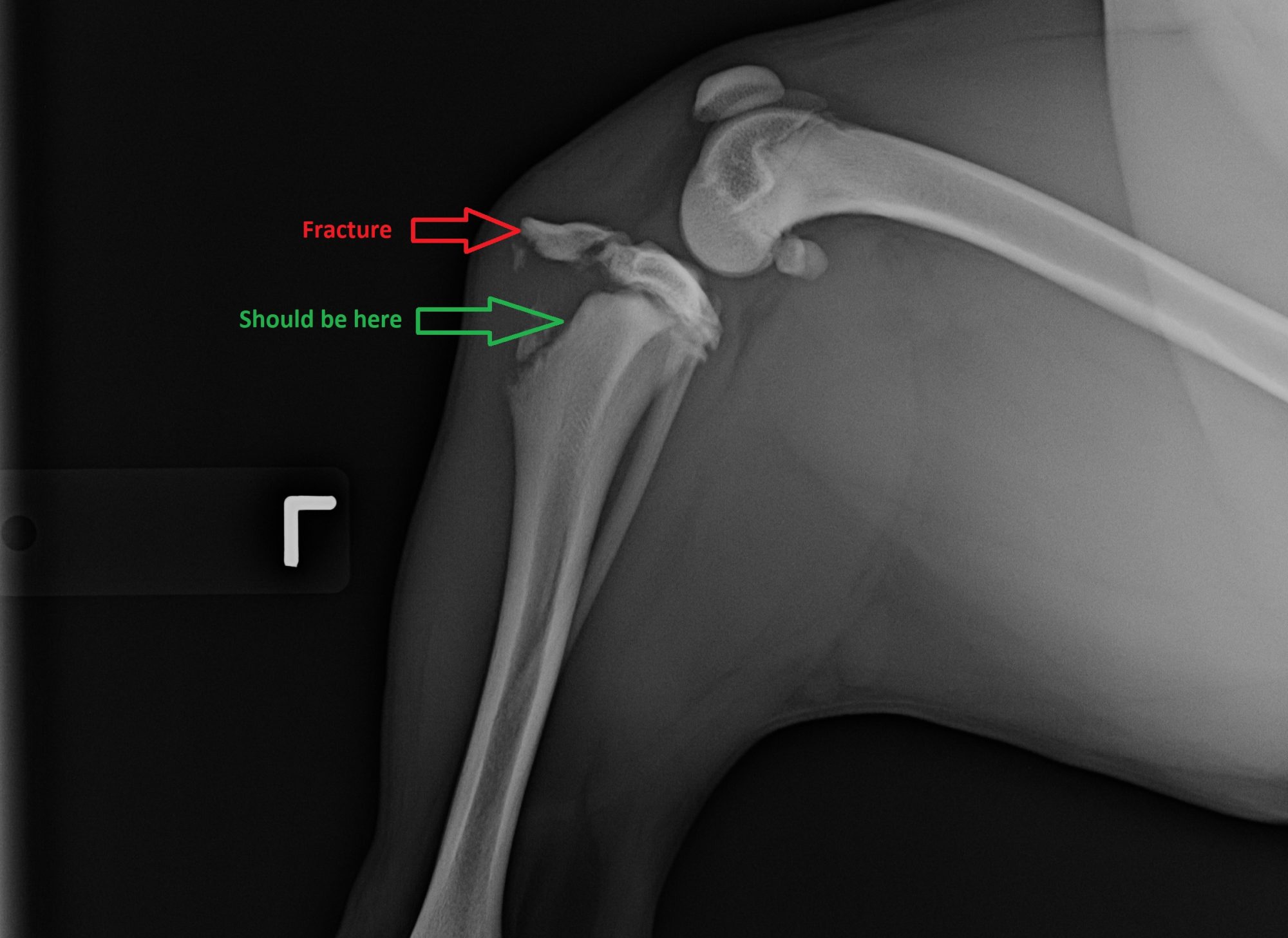
Or it could be something much worse, as in the case of Zeus.
In December of 2018, the 3 year old pit bull was limping on the left back leg. X-rays showed subtle changed. A board-certified radiologist thought it could be a partially healed fracture of the shin bone and/or a torn ACL.
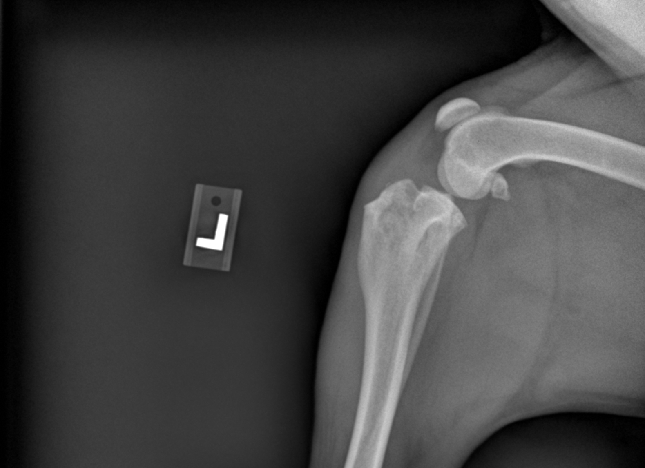
Zeus’ owner, wishing to pursue surgery, found me on my website, and asked me to do a TPLO. I referred him to a clinic where I frequently do TPLO surgeries. Surgery was delayed for various reasons.
On March 6, 2019, the day of surgery, the knee appeared unusually swollen. We repeated X-rays to be safe. Surprise… this was not at all an ACL tear. The shin bone had been literally eaten away by, most likely, bone cancer.
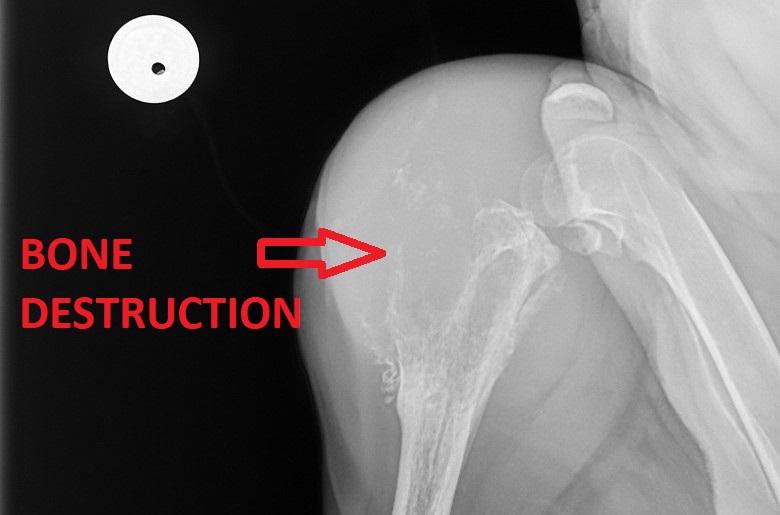
I called the owner and explained the findings. Unfortunately, the best option was amputation. Initially shocked, the owner accepted. Surgery went well and Zeus went home.
On March 7, 2019, the day after surgery, the phone update was good: “Zeus is doing well. He is getting around well three-legged. In fact, he had been only using 3 legs for a couple of months. He is eating and drinking small amounts. He has gone outside and urinated.”
Here is a video showing what a trooper Zeus was during his recovery (yes, he should have been on a leash…). He still has the Band-Aid over the incision. And he’s able to climb a few steps.
On March 13, biopsy results were back. Rather than the most common bone cancer (osteosarcoma), the cancer was hemangiosarcoma. This is an aggressive cancer of the blood vessels – in Zeus’ case, of the bone.
A few months went by, and Zeus enjoyed a happy life. Eventually, he started to limp on the right front leg. Initially, it was suspected that shifting weight to the front legs may have been responsible. Pain medications were started in August. “Zeus seems to be feeling much better since starting pain meds daily.”
Sadly, things progressed. Zeus’ family vet wrote in the medical record dated September 3, 2019: “Large visible swelling over right shoulder. Zeus is obviously in a lot of pain.”
X-rays showed that bone cancer, most likely, had spread to the arm bone (humerus). Notice how the bone looks moth-eaten.
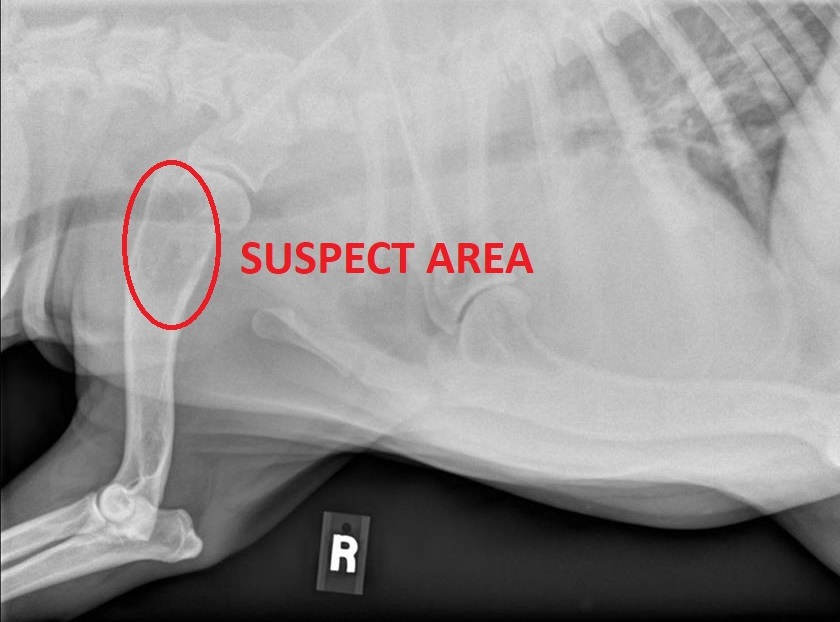
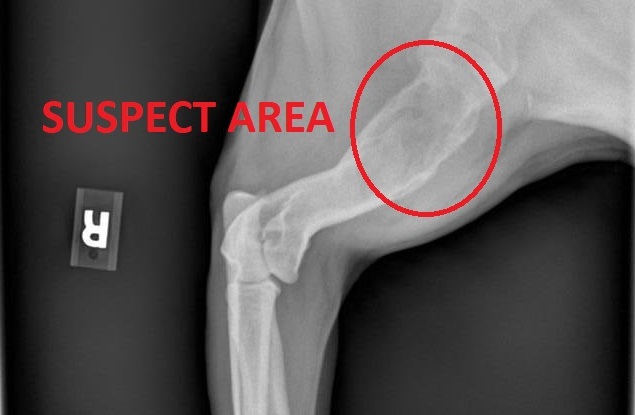
That day, Zeus was humanely euthanized.
He survived for 6 months after the amputation.
This could be the end of this blog. But I decided to call Zeus’ owner to see how he felt about this whole experience.
His comments: “Sure it was rough at times, but Zeus was happy until the end. I feel that I did everything I could for my dog. I probably did more than most people would have. But Zeus was happy and comfortable. We went to the park every day. He loved people watching. I have no regrets.”
As I always say, when we deal with a cancer patient, I’d rather have 6 months of happiness than 6 years of misery.
Zeus is a perfect illustration of that concept. Sure, amputation is an invasive surgery, but dogs bounce back very well from the surgery. They don’t care about having 3 legs. They care about being comfortable.
Zeus lived happily for 6 months after his surgery. To his owner, these 6 extra months were priceless.
Phil Zeltzman, DVM, DACVS, CVJ, Fear Free Certified

Dr. Phil Zeltzman is a traveling veterinary surgeon in Pennsylvania & New Jersey. An award-winning author, he loves to share his adventures in practice along with information about vet medicine and surgery that can really help your pets. Dr. Zeltzman specializes in orthopedic, neurologic, cancer, and soft tissue surgeries for dogs, cats, and small exotics. By working with local family vets, he offers the best surgical care, safest anesthesia, and utmost pain management to all his patients. Sign up to get an email when he updates his blog, and follow him on Facebook, too!
Simone falls out of a window!
Simone, a 1 year old Chihuahua, was relinquished to a rescue organization in New Jersey (www.facebook.com/SecondChancePetAdoptionLeague). Her story was nebulous, but it sounds like she sustained a 10 foot “fall” through a window. The story doesn’t say how…

That’s a pretty big fall for a 5 pound dog… Luckily, Simone’s only injury was a broken forearm (radius and ulna), just above the wrist.
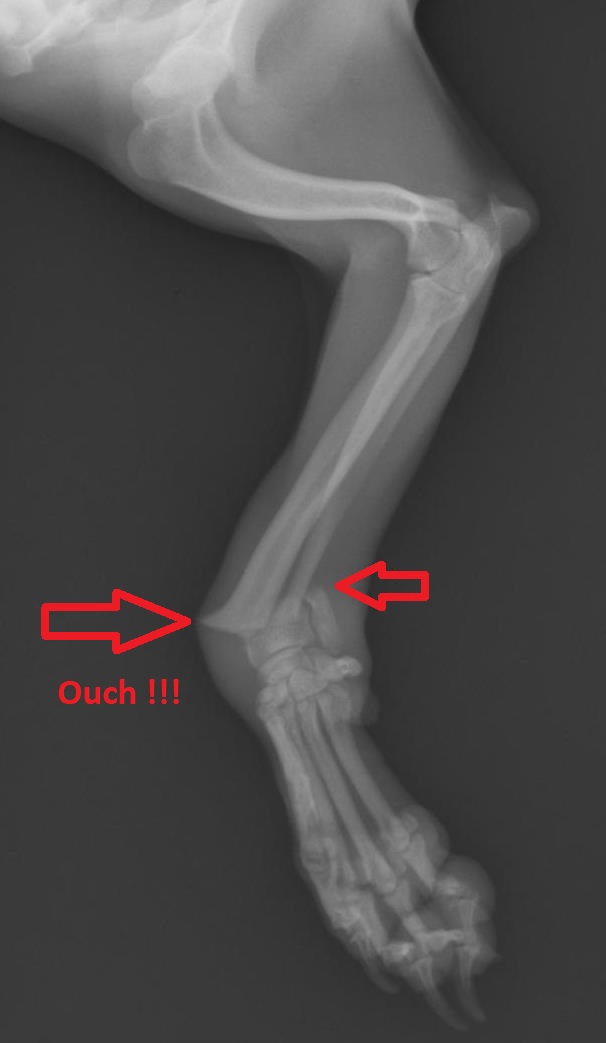
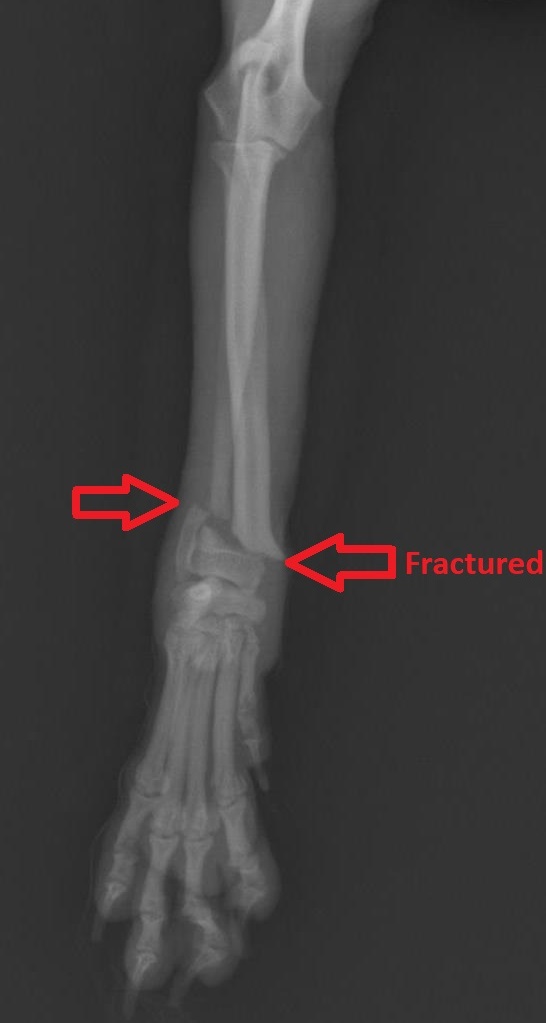
The Animal Clinic of Morris Plains in NJ reached out to me to fix Simone.
Because there was so little space below the fracture, we “cheated” and used a special plate called a T- plate and 5 tiny screws. The T part allowed us to fit more screws below the fracture.
To reinforce the repair even more, a splint was placed on the leg after surgery. Simone recovered smoothly from anesthesia and went to recover in her foster home.
After 2 months of strict confinement and TLC, Simone’s bone looked healed on X-rays.
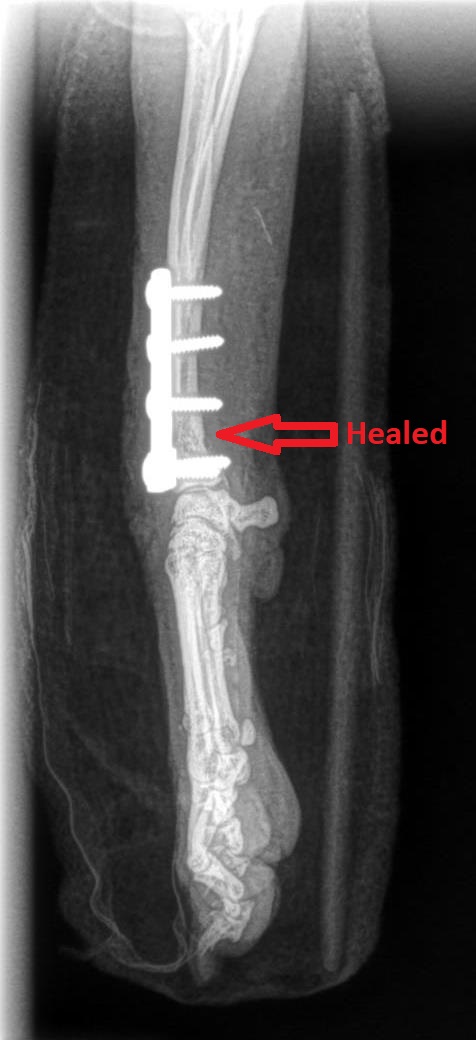
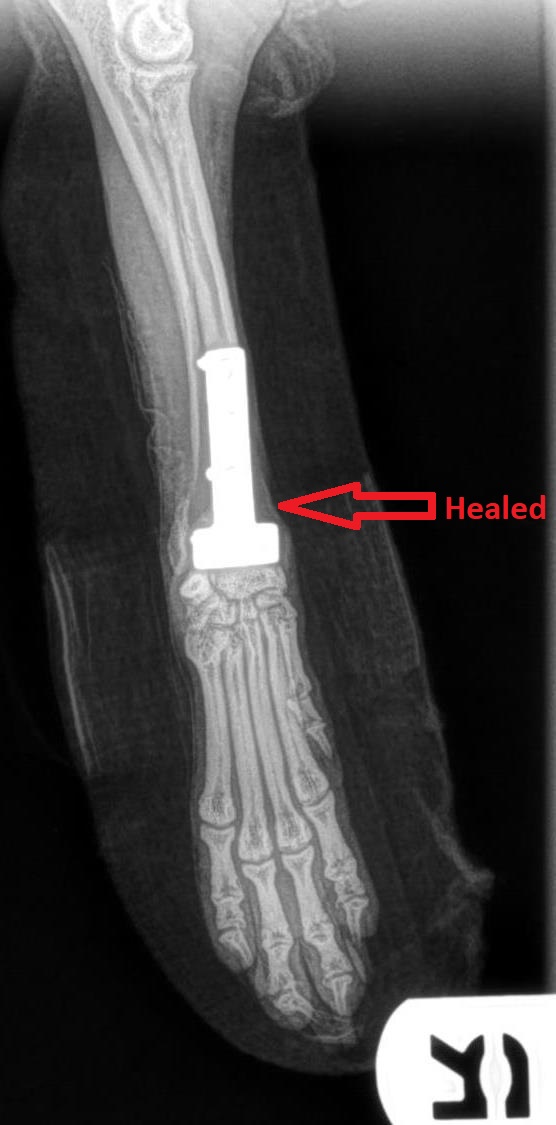
It is now time to start to rehab Simone. This simply means that she will need to be walked longer and longer to rebuild muscle. Then she can start to live a happier life with her new family.
Phil Zeltzman, DVM, DACVS, CVJ, Fear Free Certified

Dr. Phil Zeltzman is a traveling veterinary surgeon in Pennsylvania & New Jersey. An award-winning author, he loves to share his adventures in practice along with information about vet medicine and surgery that can really help your pets. Dr. Zeltzman specializes in orthopedic, neurologic, cancer, and soft tissue surgeries for dogs, cats, and small exotics. By working with local family vets, he offers the best surgical care, safest anesthesia, and utmost pain management to all his patients. Sign up to get an email when he updates his blog, and follow him on Facebook, too!
Age is not a disease – Kali’s story
Kali, a 15 year old Australian cattle dog, was drinking and peeing more than usual. These are very vague signs, and thankfully her owner acted on them. Then Kali had vomiting and diarrhea.
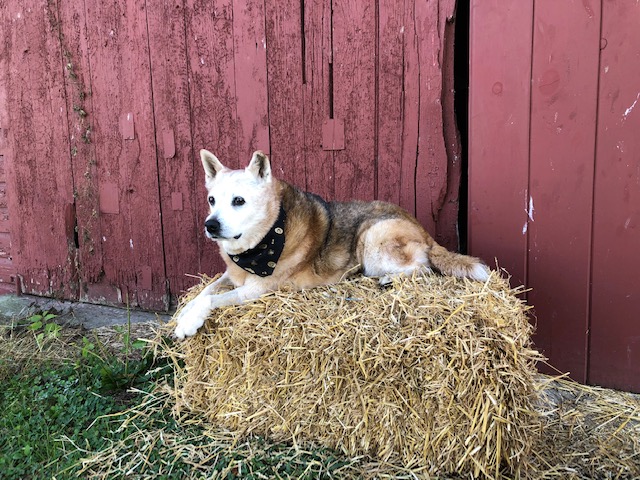
Since these signs can be seen in multiple conditions, Kali had a physical exam. Blood work showed high liver numbers, so she had X-rays, which showed a liver mass.
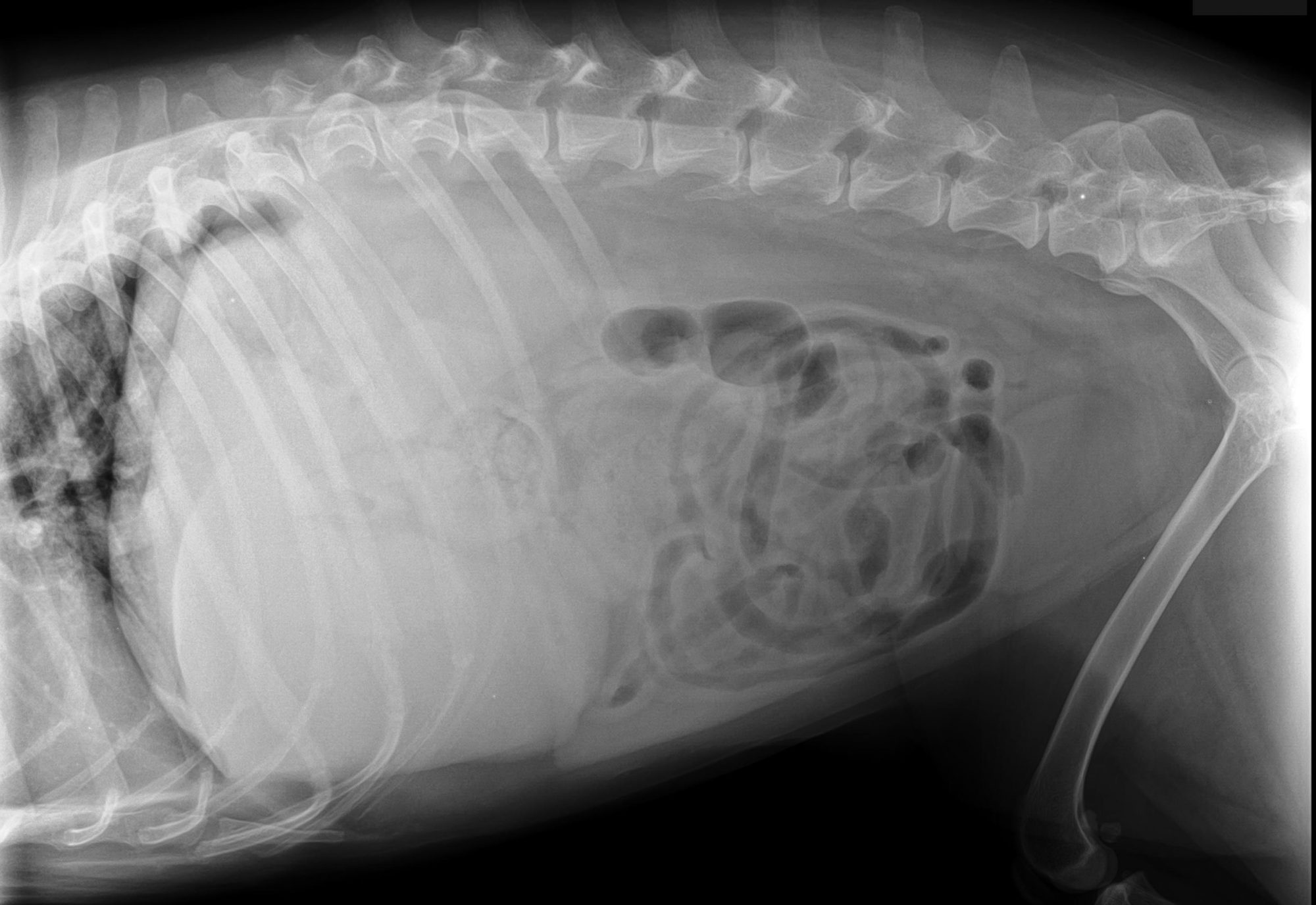
An ultrasound revealed that the mass was the size of a pear.
Statistics tell us that most liver masses are cancerous. Kali’s owner didn’t know what to do. “Friends and family” told her that it was not reasonable to do surgery on an ancient dog with cancer.
Yet amazingly, this loving pet owner decided to give her 15 year old dog a chance. She chose to have the liver mass removed at Harmony Animal Hospital in NJ.
Kali was given IV fluids. Pain medications and anesthesia drugs were chosen to minimize the impact on her liver.
BEWARE, the next picture is graphic. You have been warned!!!
In surgery, the mass turned out to be much larger than anticipated. Instead of being the size of a pear, it was the size of a cantaloupe!
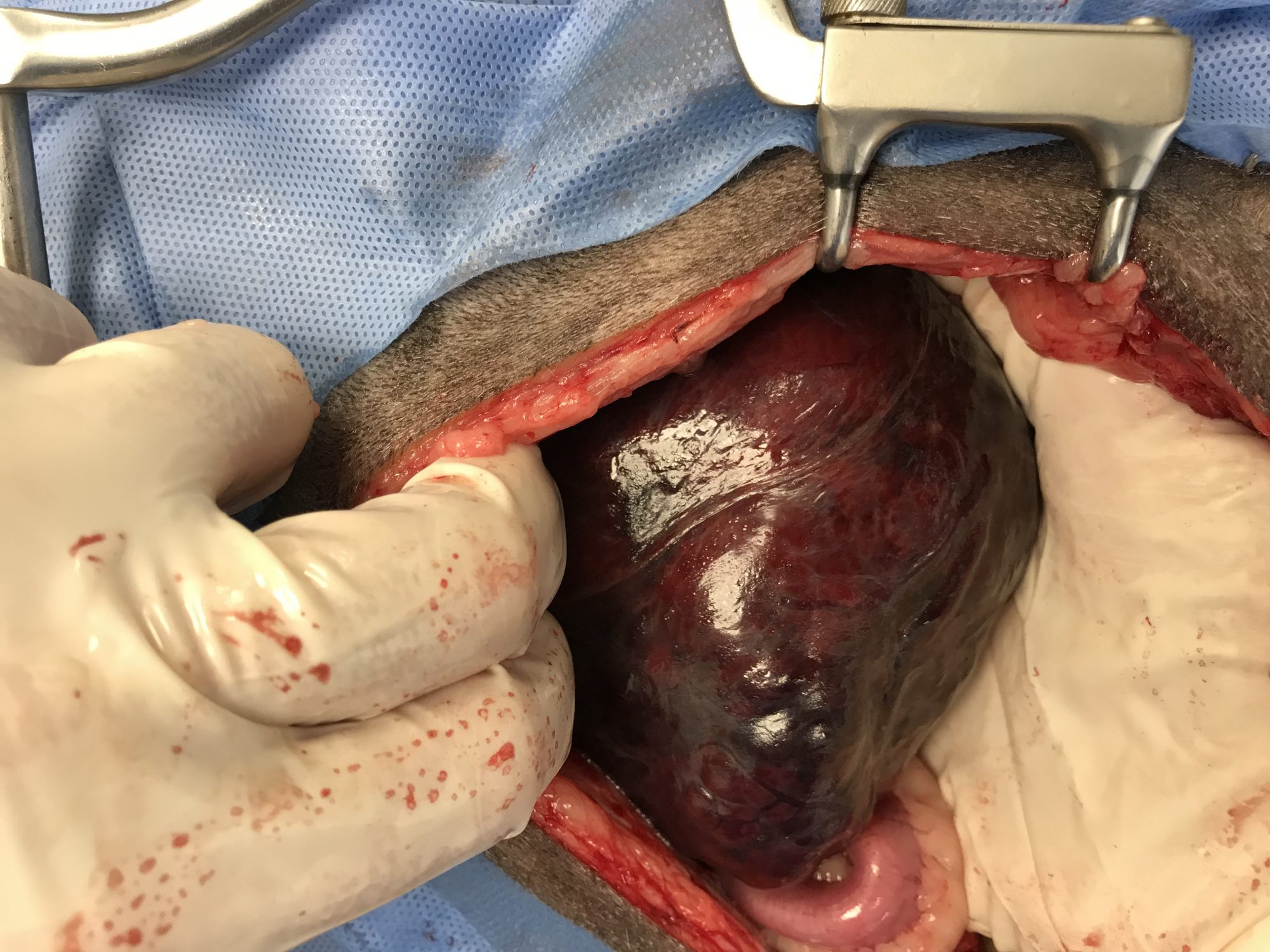
Because the risk was much higher than anticipated, I decided to call Kali’s owner in the middle of surgery to brainstorm and to make a decision together. Removing a mass this large greatly increased the risk of bleeding.
Of course, leaving a mass this large had its own risks. Left alone, the mass would continue to grow and would likely rupture, which would lead to internal bleeding. After careful consideration, the owner decided to continue with surgery.
So we finished the surgery, which was not exactly an easy task… We did have some significant bleeding. But overall surgery went well.
Here is the mass postop. The coin next to it is an American quarter… (a bit under 1 inch or 2.5 cm in diameter).
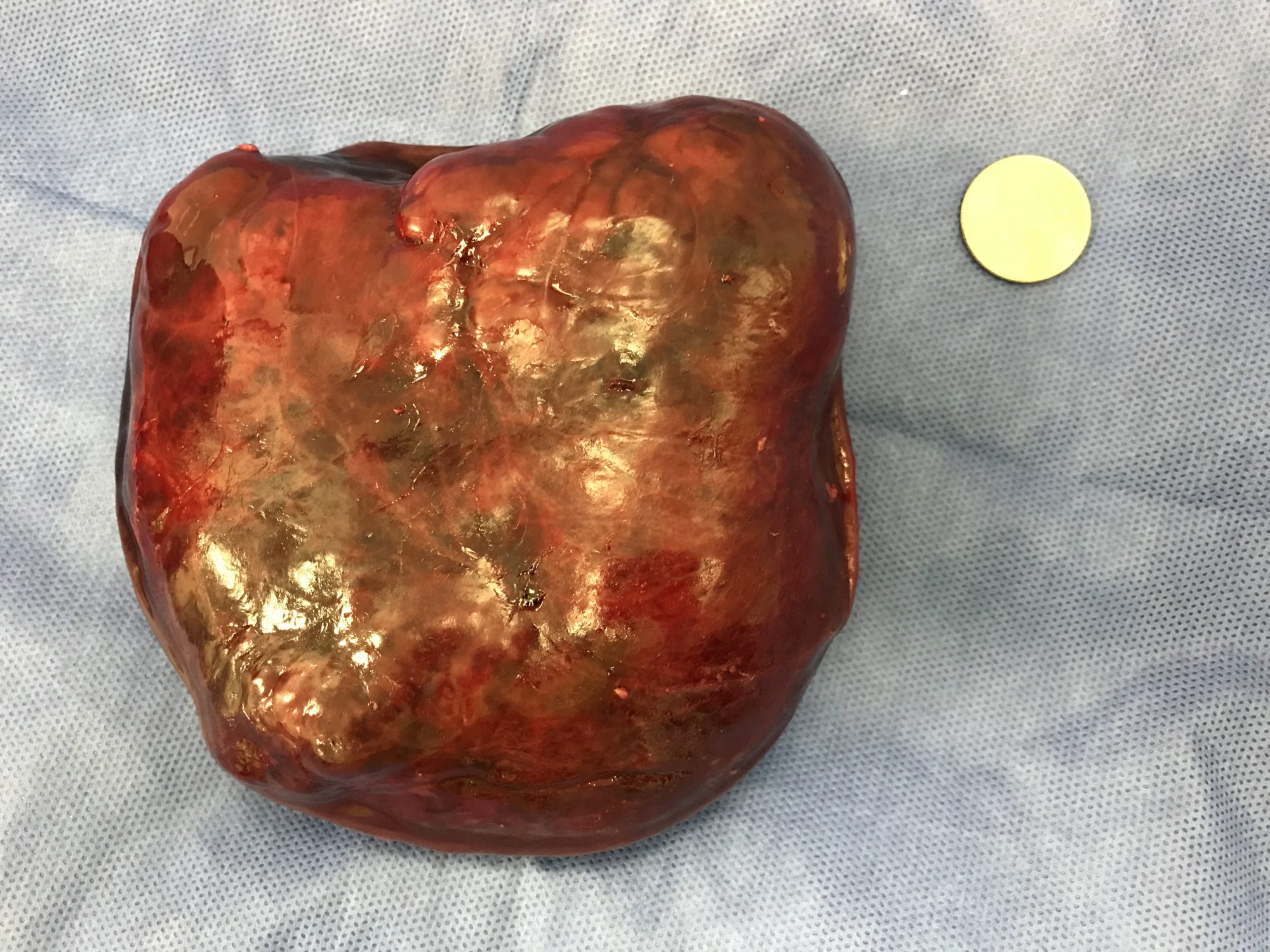
Kali stayed overnight on IV fluids, pain medications and antibiotics. Her red blood count stayed surprisingly high.
I stopped by the clinic the next day. Kali looked pretty good.
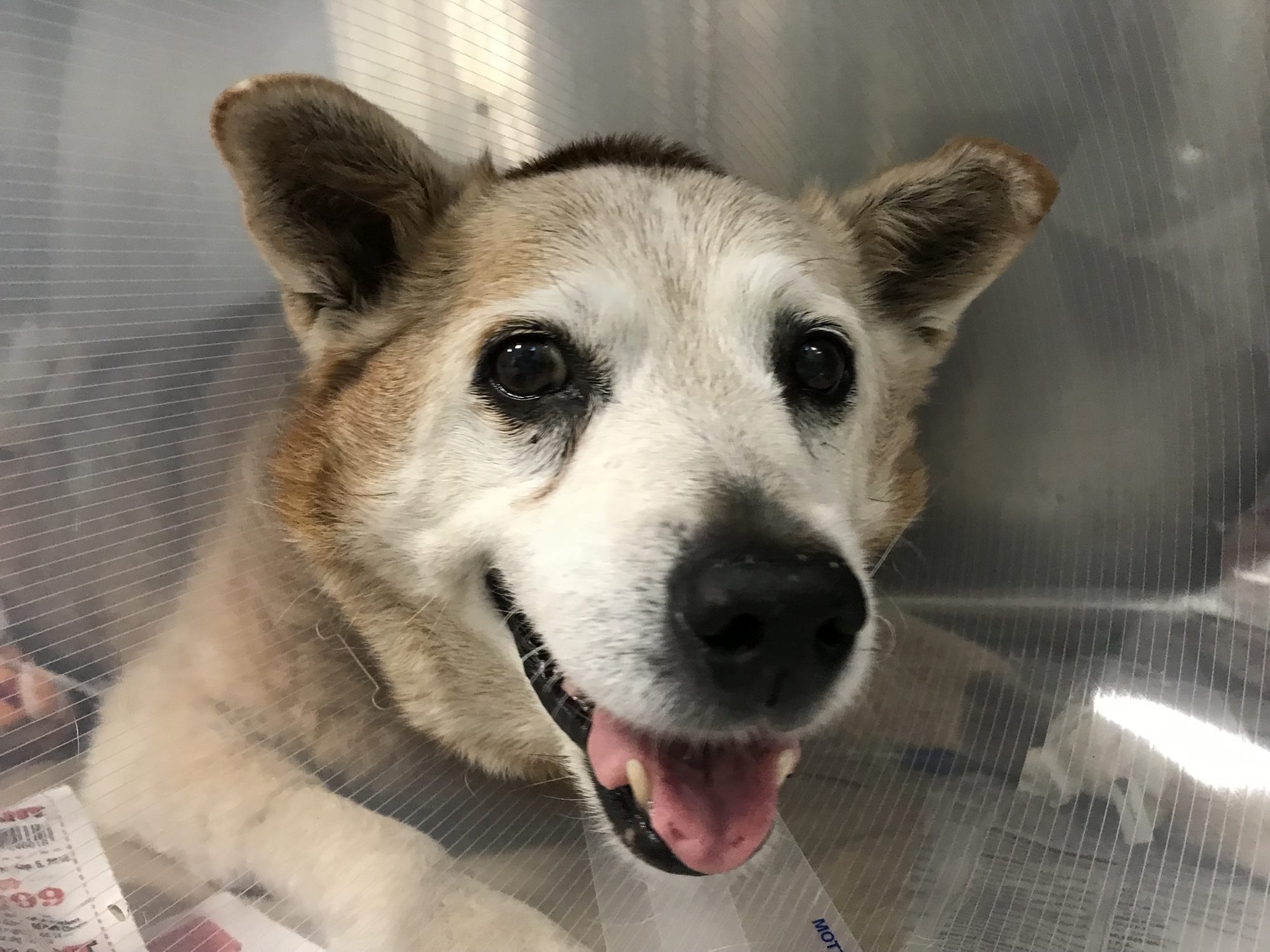
Two days later, Kali was bright and alert. She was ready to go home to heal and rest.
A week later, the biopsy results came back as… benign! Unbelievably, this enormous mass, that everybody was convinced was cancer, turned out to be a benign tumor (hepatocellular adenoma).
Twelve days after surgery, the update was very positive: “She is doing wonderful! Feeling a lot better, more like herself. She has a good appetite and good energy.”
One month later, her owner said that she “couldn’t be happier. Kali is doing phenomenal. She’s happy and back to her old self.”
And the best part: “Choosing to do surgery in spite of the odds and in spite of her age was totally worth it.”
Then something unusual happened at home:
“We recently found her on the couch sleeping upside down… and it dawned on us that it has been almost a year or so since she stopped jumping on furniture. We thought it was because of her arthritis in her elbows… but now we believe the tumor was making her uncomfortable to jump and lay on her back.”
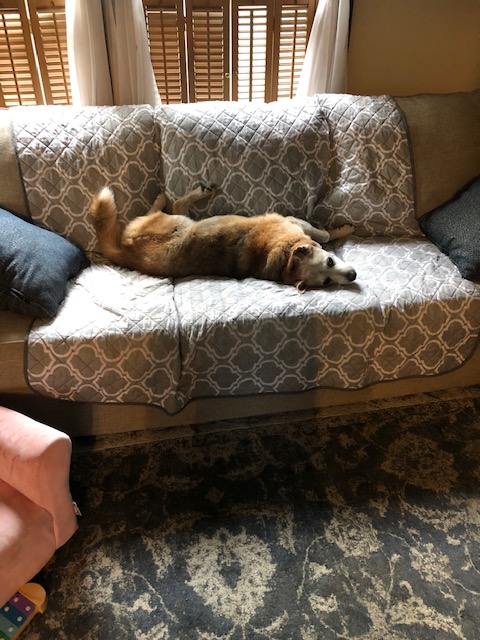
So what’s the morale of this story?
. Just because your pet is old, doesn’t mean that you should give up.
. Don’t (always) listen to friends and family. They have good intentions, but ultimately you should make a decision you are comfortable with. You have to live with your decision. They don’t.
. Never assume. Just because everybody “knows” a mass is cancer, doesn’t mean that anybody is right. The only test I trust is a biopsy read by a board-certified pathologist.
. As I have said many times before, “Age is not a disease.”
Phil Zeltzman, DVM, DACVS, CVJ, Fear Free Certified

Dr. Phil Zeltzman is a traveling veterinary surgeon in Pennsylvania & New Jersey. An award-winning author, he loves to share his adventures in practice along with information about vet medicine and surgery that can really help your pets. Dr. Zeltzman specializes in orthopedic, neurologic, cancer, and soft tissue surgeries for dogs, cats, and small exotics. By working with local family vets, he offers the best surgical care, safest anesthesia, and utmost pain management to all his patients. Sign up to get an email when he updates his blog, and follow him on Facebook, too!

